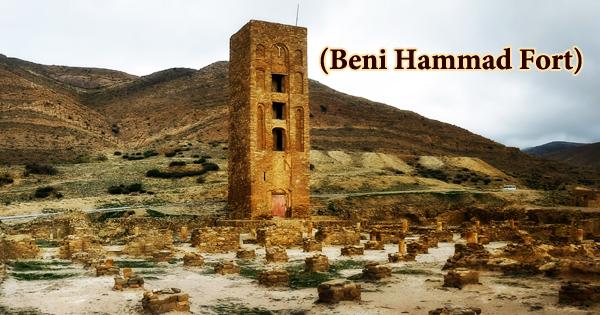Beni Hammad Fort, also known as the Al Qal'a of Beni Hammad, is an ancient fortified city located in the M'Sila Province of Algeria. The city was built in the 11th century by the Hammadid dynasty, a Berber dynasty that ruled over the region from 1014 to 1152.Beni Hammad Fort served as the capital of the Hammadid dynasty for approximately 150 years, until the capital was moved to the city of Béjaïa in the 13th century. The city was strategically located on a hilltop, which provided a natural defense against invaders.The city was renowned for its impressive architecture, including its mosque, which was considered one of the largest and most beautiful in the Islamic world at the time. The mosque was built in the early 11th century and was renowned for its unique architectural style, which combined elements of Islamic and Byzantine architecture. The mosque was supported by a complex system of arches and columns, which gave it a striking appearance.In addition to the mosque, the city also featured a palace, a library, and a number of other public buildings. The city was home to a thriving community of artisans, including metalworkers, potters, and weavers.Beni Hammad Fort was abandoned in the 13th century, after the Hammadid dynasty moved its capital to Béjaïa. The city was rediscovered by French archaeologists in the 19th century, and it has since become a popular tourist destination and a UNESCO World Heritage site. The ruins of the city offer a fascinating glimpse into the rich history and cultural heritage of the Berber people of Algeria.The city was founded by the Hammadid ruler Hammad ibn Buluggin in 1007, who chose the location for its strategic advantages, including its natural defenses and proximity to valuable trade routes. The city quickly grew in importance, both as a political and cultural center.In addition to its impressive architecture, Beni Hammad Fort was known for its thriving markets and its skilled artisans, who produced high-quality textiles, pottery, and metalwork. The city was also home to a number of scholars and intellectuals, who helped to advance the fields of science, medicine, and literature.Over time, however, the city began to decline, as the Hammadid dynasty struggled with internal divisions and external threats from rival dynasties and invading forces. By the 13th century, the city had been largely abandoned, and its impressive buildings had fallen into disrepair.Today, visitors to Beni Hammad Fort can explore the ruins of the city, including its mosque, palace, and other public buildings. The site is particularly impressive for its intricate architectural details, including the intricate stonework and decorative motifs that adorn many of the buildings. The site is a testament to the ingenuity and creativity of the Hammadid dynasty, as well as the rich cultural heritage of Algeria and the broader North African region.The city was once home to over 100,000 people, making it one of the largest and most important cities in North Africa during the 11th century.The mosque at Beni Hammad Fort is considered to be one of the most significant examples of Islamic architecture in Algeria, and it is known for its distinctive horseshoe arches and decorative carvings.The city's library was said to have contained over 100,000 books, making it one of the largest collections of its time.The city's palace was an impressive structure that featured multiple courtyards and elaborate gardens. It was used by the Hammadid rulers for both official and private functions.The city's fortifications included a series of walls and towers that were designed to protect the city from attack. These fortifications were built using local stone and were augmented with wooden gates and other defensive features.The city's decline has been attributed to a combination of factors, including political instability, environmental degradation, and competition from other cities and dynasties in the region.Today, Beni Hammad Fort is a popular tourist destination and a UNESCO World Heritage site. It is recognized as an important cultural and historical landmark that offers visitors a fascinating glimpse into the rich and complex history of Algeria and the wider North African region.
Followers
Labels
- Abu Mena 1
- Ajanta Caves 10
- Bahrain Pearling Trail 1
- BLOG 2
- Casbah of Algiers 1
- Chichén Itzá 1
- Dilmun Burial Mounds 1
- Djémila 1
- Giza pyramid complex. 1
- Great Barrier Reef 2
- Great Living Chola Temples 8
- International Campaign to Save the Monuments of Nubia 1
- Islamic Cairo 1
- Keoladeo National Park 5
- Machu Picchu 9
- Petra 6
- Qal'at al-Bahrain 1
- Qal'at Bani Hammad 1
- Saint Catherine's Monastery 1
- Sun Temple 7
- Sundarbans National Park 3
- Taj Mahal 11
- Tassili n'Ajjer 1
- Thebes 1
- Timgad. 1
- Tipaza. 1
- Wadi al Hitan. 1
- Western Ghats 4
- World Heritage History 12
Contact Form
Popular Posts
Qal'at al-Bahrain
February 25, 2023
Djémila
February 24, 2023
Saint Catherine's Monastery
February 27, 2023
Bahrain Pearling Trail
February 25, 2023
Islamic Cairo
February 27, 2023
Tassili n'Ajjer
February 24, 2023
Tags

Recent Posts
3/recent/post-list
Categories
- Abu Mena 1
- Ajanta Caves 10
- Bahrain Pearling Trail 1
- BLOG 2
- Casbah of Algiers 1
- Chichén Itzá 1
- Dilmun Burial Mounds 1
- Djémila 1
- Giza pyramid complex. 1
- Great Barrier Reef 2
- Great Living Chola Temples 8
- International Campaign to Save the Monuments of Nubia 1
- Islamic Cairo 1
- Keoladeo National Park 5
- Machu Picchu 9
- Petra 6
- Qal'at al-Bahrain 1
- Qal'at Bani Hammad 1
- Saint Catherine's Monastery 1
- Sun Temple 7
- Sundarbans National Park 3
- Taj Mahal 11
- Tassili n'Ajjer 1
- Thebes 1
- Timgad. 1
- Tipaza. 1
- Wadi al Hitan. 1
- Western Ghats 4
- World Heritage History 12
Tags
Designed with by Way2Themes | Distributed by Magazine Blogger Template



0 Comments